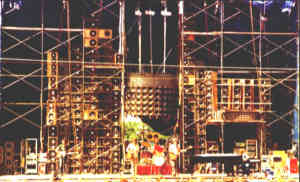April 26, 2005
The Wall of Sound
Whether you liked their music or not, the Grateful Dead had probably the best touring sound system out there. Here is a nice description of it and why it was so good:The Grateful Dead Sound SystemThe obligatory photo:
The Grateful Dead sound system is really 11 independent systems or channels as shown in the table below. The source of sound are located behind and above the performers so they hear what the audience hears. Only one source location for each channel is used to cover the entire hall and the music is clearer both on stage and in the audience. The stereo effect is very satisfying and natural to persons all over the hall. Intermodulation distortion between instruments is of course non-existant.
Excessive reverberation and echos often impair the sound quality when performing in sports arenas. These buildings often sound worse than simple observation of reverberation times might indicate due to troublesome wall surfaces creating echoes. Conventional systems which have multiple sources for each sound add additional delays. The result is a confusing sound which causes the musicians and sound system operators to turn up the level in an effort to overcome this muddle of sound by the limiting effect of the ear. The Grateful Dead system with its single source for each instrument projects clear sound farther back into these cavernous nightmares, and since the sound from each instrument comes from a different direction, the echoes are more diffuse and therefore less objectionable.
Conventional systems are set up low to the ground and the major energy is projected straight back where it strikes the rear wall and is reflected back to the musicians with a delay approaching a half-second. Extremely high stage monitor levels are required to overcome this echo and musicians often comment that they can't hear well but that the high level hurts their ears. The low angle of aim also causes additional reflections from side and front walls which detract from clarity in the audience area. In the Dead's system the source of sound is higher and aimed down. The original sound is partly absorbed by the audience and the first reflection from the real wall is directed down into the audience for further absorption. In this way, the apparent reverberation is substantially reduced, and this effect is significant when the only absorptive material in a reinforced concrete enclosure is the audience.

Comments
Post a comment